KEY POINTS
- There is widespread use of buffering agents among athletes, and the current body of scientific evidence indicates there is a potential performance benefit for sodium bicarbonate, sodium citrate and beta-alanine.
- Evidence supporting the efficacy of buffering agents for real-world performances of athletes is however somewhat limited: specifically in highly trained female athletes; in extreme environmental conditions (e.g., altitude and heat); and the use of combined buffering agents.
- A performance benefit has been reported in only 21% of the existing studies in highly trained females, 22% of studies in extreme environments, and 9% of studies with combined buffering agents. The current evidence is however limited by the small number of studies (a total of 58 studies; 29 in females, 18 in extreme environments, and 11 in combined buffering agents).
- It is therefore recommended that future research focuses on i) studies in highly trained females, which include quantification of menstrual status, ii) buffering studies conducted at altitude with performance tests simulating real-world competitive events, and iii) the use of various combinations of buffering agents by highly trained and elite research participants.
- To develop buffering protocols for individual athletes, it is recommended that a staged and systematic approach is used - that identifies opportunities for co-supplementation with other evidence-based products, quantifies buffering capacity, gastrointestinal symptoms, and other side effects where feasible, and optimizes key moderating factors, including dose, timing, exercise duration, and intensity.
INTRODUCTION
The recent International Olympic Committee consensus statement on nutritional supplements recognized the widespread use of buffering agents by athletes and reported that for two of these buffering agents, sodium bicarbonate and beta-alanine, there is scientific evidence for beneficial effects on performance in specific sports and events (e.g., 400 m running, 100 m swimming and some team sports) (Maughan et al., 2018). There is also growing evidence that other buffering supplements, such as sodium citrate, can be effective in improving performance during similar events (Oliveira et al., 2022). Sodium bicarbonate and sodium citrate work by enhancing extracellular buffering capacity (blood bicarbonate concentration [HCO3-] and pH), whilst the key mechanism of action for beta-alanine ingestion is to increase muscle carnosine (Saunders et al., 2017). Evidence-based recommendations have been established for each of these supplements, which focus on the dose and timing of supplement ingestion, and the duration and intensity of exercise that is most likely to benefit from these supplements. Recommendations currently suggest that sodium bicarbonate be taken as an acute and/or split dose of 0.2 – 0.4 g/kg, 60 – 150 min pre-exercise, and beta-alanine be taken as a chronic dose of 3.2 – 6.4 g/day for at least four weeks and that sodium citrate be taken as an acute dose of 0.5 g/kg, 200 – 240 min pre-exercise (Figure 1) (Maughan et al., 2018; Urwin et al., 2021). The current recommendations state that sodium bicarbonate and beta-alanine are most effective for exercise performance of up to 10 min duration and sodium citrate is most effective for exercise of up to 7 min duration.

A substantial volume of scientific research on buffering agents has been completed, starting as early as the 1930s (Dennig et al., 1931; Dill et al., 1932), although it is challenging to objectively determine how these research findings can translate to some specific real-world practices of well-trained athletes. More specifically, the use of buffering agents in highly trained female athletes (Smith et al., 2022), in extreme environmental conditions (e.g., training and/or competing in hot weather conditions; > 25°C or at altitude > 1400 m) (Cerullo et al., 2020; Guy et al., 2015; Mujika et al., 2019; Stellingwerff et al., 2019), and when using combinations of buffering agents (Burke, 2017; Saunders et al., 2017) has been investigated to only a limited extent. The aim of this Sport Science Exchange article (SSE) is to provide relevant information to performance support practitioners and coaches by providing a practical evaluation of the evidence on buffering agents. Additionally, the article provides a broader practical guide to assist practitioners seeking to implement an evidence-based ingestion buffering protocol, which also considers athletes’ use of other nutritional supplements and the potential for gastrointestinal symptoms and other side effects when using buffering agents.
REVIEW OF RESEARCH ON BUFFERING
Studies that focused on buffering agents were evaluated in three separate contexts: highly trained female athletes, in extreme environmental conditions, and combined buffering agents. An analysis method was used that specifically targeted the potential translation of findings to high-performance athletes, rather than trained or recreationally active populations. The analysis methods comprised three levels:
- Moderating variables (supplement dose and timing, and exercise test duration and intensity) which are factors that can influence athletes’ responses to buffering agents, as determined by previous reviews of the literature (Oliveira et al., 2022; Saunders et al., 2022; Urwin et al., 2021). For the moderating variables, we used a ‘traffic light system’ to indicate the proportion of studies that were consistent with the evidence-based recommendations. The traffic light system indicated whether the number of studies that were consistent was low (≤ 40%; red), moderate (> 40%; < 80%; yellow) or high (≥ 80%; green) (Table 1).
- Design factors (e.g., use of crossover or matched group study design, familiarization trials, pre-test dietary standardization, performance tests that were representative of the real-world competitive demands of athletes), which can enhance the translation of research findings to real-world contexts (Betts et al., 2020; Close et al., 2019), and the quantification of gastrointestinal symptoms (for sodium bicarbonate and sodium citrate) and other side effects (e.g., paraesthesia after beta-alanine supplementation) (Breitkreutz et al., 2007; Liu et al., 2012; Saunders et al., 2014). The ‘traffic light system’ was also used to indicate the proportion of studies that implemented the required design factors (Table 1).
- Athlete-specific factors (recruitment of highly-trained, or at least ‘Tier 3’ athletic calibre/national level, as defined by McKay et al., 2022), athletes as research participants, measures of increased buffering capacity, and reported improvements in performance tests that replicate real-world competitive events (Close et al., 2019; Harris et al., 2006; McKay et al., 2022; Oliveira et al., 2022). Venn diagrams were used to indicate the proportion of studies that met the requirements for each of these factors, and the interaction of those factors (Figures 2, 3, 4).
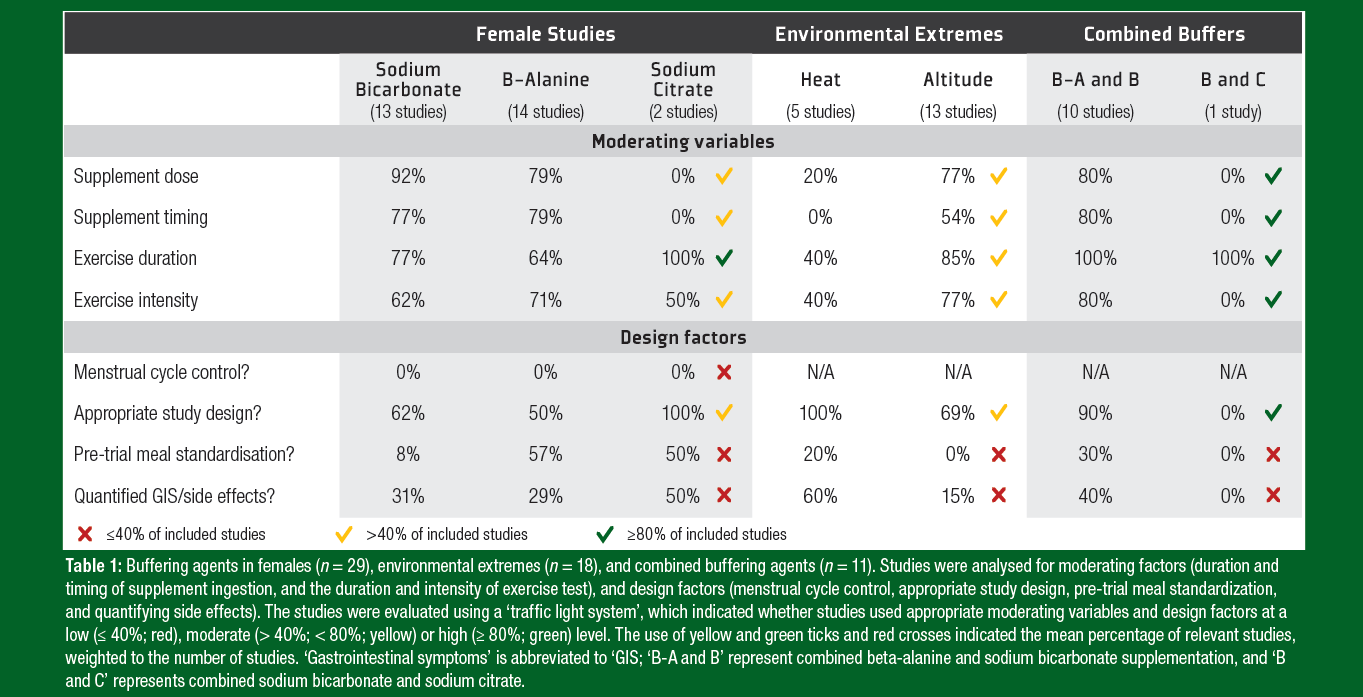
Highly Trained Female Athletes
The efficacy of buffering agents specific to females is relevant, given that supplement use in female athletes across different sports is similar (Sundgot–Borgen et al., 2003) and in some cases, higher (e.g., 57% in females vs 47% in males, Sobal et al., 1994) than in males. Despite this, only 4% of sodium bicarbonate studies and 8% of all beta-alanine studies have included female-only research populations (Smith et al., 2022). Further, in a recent review of the sodium citrate literature, only two of the 33 included studies (6%) investigated female-specific responses to the supplement (Urwin et al., 2021). The effects of buffering agents may differ between male and female athletes, due to the lower muscle mass and number of type II muscle fibres in females, which may lead to a reduced capacity for glycolysis and lower accumulation of hydrogen ions [H+] or lactate [La-] (Green et al., 1984; Hegge et al., 2016; Janssen et al., 2000; Porter et al., 2002; Russ et al., 2005). There is also some potential impact of menstrual status and the use of hormonal contraceptives on exercise performance in females (Elliott-Sale et al., 2020; McNulty et al., 2020), which might interact with the effects of buffering agents. This potential interaction of estrogen and progesterone with buffering agent efficacy has been poorly considered to date, with just 4% and 6% of studies including female participants examining sodium bicarbonate and beta-alanine, respectively, considering menstrual status (Elliott-Sale et al., 2021).
Within all the studies on buffering agents in highly trained female athletes (n = 29), only 21% reported a performance benefit in exercise tests that represented real-world performance efforts (e.g., running and cycling time trials, field-based tests replicating team sports, Figure 2). There was a performance benefit reported in 38% of sodium bicarbonate studies, no sodium citrate studies, and 7% of beta-alanine studies in female athletes. In the sodium bicarbonate literature, a high percentage (92%) of studies used doses demonstrated to benefit performance. Over one-third of studies (38%) used an exercise test which was not of an intensity likely to be improved with buffering agents due to a lack of acid-base disturbances. For sodium citrate studies, there was limited opportunity to identify performance benefits, given the small number of studies (n = 2), of which none used a supplement dose or timing that was consistent with the current evidence-based guidelines for this supplement (Table 1) (Maughan et al., 2018). None of the included studies investigating buffering agents in females adequately quantified, menstrual cycle factors (Table 1). More information on performance effects in highly trained female athletes could be elucidated in future research that focuses on sodium citrate studies, given their rarity, and studies with adequate classification and control of menstrual status.
Extreme Environmental Conditions
Many major international events (e.g., World Championships, Olympic Games) are held in hot and/or hypoxic conditions, creating challenging scenarios for athletes (Guy et al., 2015). Training and competing in endurance events can be substantially impaired in hot conditions (> 25°C) due to acute physiological responses such as decreased plasma volume (McDermott et al., 2017), and a greater reliance on anaerobic
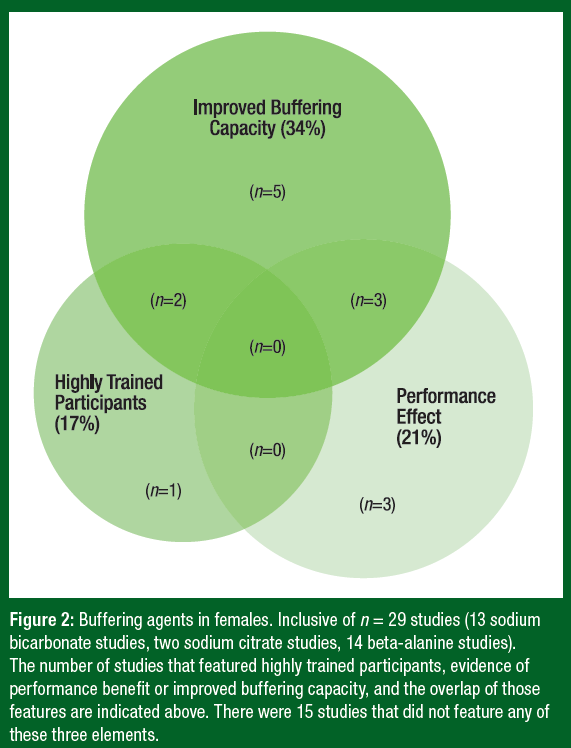
metabolism compared with equivalent exercise in cool or temperate conditions. This leads to an increased accumulation of La- and H+ (Febbraio, 2001). Meanwhile, training in hypoxic conditions of ≥ 1400 m is often completed by athletes to prepare for competitions (both at altitude and at sea level), given that exposure to the low oxygen environment may elicit physiological responses associated with chronic exposure to the reduced oxygen availability, including an increased hemoglobin mass and maximal oxygen consumption (Mujika et al., 2019). Further, an increased release of noradrenaline by the sympathetic nervous system can facilitate an increased reliance on blood glucose metabolism and increased [La-] and [H+] during submaximal exercise, provided athletes are able to maintain their sea-level training pace or intensity (Millet et al., 2010; Mujika et al., 2019). The documented acute responses to heat and hypoxia thereby indicate that supplementation with buffering agents in the acute phase of exposure to heat and/or altitude may improve athletes’ capacity to maintain training intensity.
Of the 18 studies investigating buffering agents in extreme environments, there were five studies in hot conditions (mean ± SD ambient temperature 31.4 ± 2.2°C and relative humidity 48.0 ± 8.4%) and 13 studies in hypoxia (mean ± SD elevation 3181 ± 1024 m). Of these studies, only 22% reported a performance benefit (three altitude studies and one heat study) (Figure 3). In the heat literature, 20% of studies used the recommended supplement dose, none used the recommended supplement timing, and 40% of studies used exercise bouts of recommended duration and intensity. However, it was noticeable that several studies conducted in hot conditions
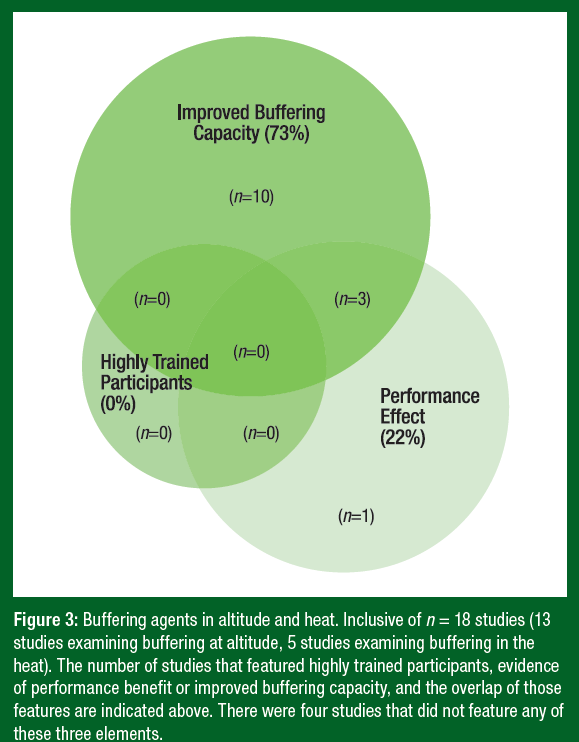
were focused on the effects of sodium bicarbonate or sodium citrate on hydration status rather than quantifying buffering capacity and performance (Nelson et al., 2008; Suvi et al., 2018; Vaher et al., 2015), which may explain the lack of consistency with buffering-specific guidelines. A common limitation of the heat-specific studies was the absence of familiarization trials (in 80% of included studies). No studies conducted in the heat recruited highly trained athletes (Tier 3/national level or above, McKay et al., 2022) therefore there is currently very limited transferability of these research results to high-performance sport. Among studies conducted at altitude, 85% used an exercise test duration consistent with current evidence-based guidelines (Maughan et al., 2018), although there were limitations in familiarization measures (included in only 23% of studies), no pre-test dietary standardization, quantification of gastrointestinal symptoms or other side-effects (15%) and performance tests with relevance to real-world outcomes (38%). A focus in future research on the recruitment of highly trained athletes for studies conducted in hot and/or hypoxic conditions may increase the relevance of research findings to competition outcomes in high performance sport. An increase in real-world relevance may also be achieved by conducting research studies on buffering agents at the lower altitudes more commonly used by athletes (e.g., Font-Romeu, France (1,850 m), Colorado Springs, USA (1,860 m) and Kunming, China (1,860 m)) for altitude training (Millet et al., 2010).
Combined Buffering Agents
The use of combined products and supplements has been documented in athletes (Erdman et al., 2007; Shaw et al., 2016). Within the published literature, one of the most frequently investigated supplement combinations is sodium bicarbonate and beta-alanine (Burke, 2017; Gilsanz et al., 2021; Saunders et al., 2017). Theoretically, there is potential for an additive effect of extracellular buffering via increases in blood pH and [HCO3-] and intracellular buffering via increased muscle carnosine content compared with the use of either strategy alone. There is some evidence that combined beta-alanine and sodium bicarbonate supplementation may elicit augmented performance benefits (Gilsanz et al., 2021; Saunders et al., 2017), particularly when compared with beta-alanine ingestion in isolation.
Of the 11 studies investigating the combination of buffering agents, 91% (10 studies) explored sodium bicarbonate and beta-alanine supplementation, and one explored sodium bicarbonate and sodium citrate supplementation. We compared the effect of the combined supplements, to supplements in isolation (rather than a placebo), to reflect choices that athletes and coaches may encounter when preparing for competitive events. When the combined effect of beta-alanine and sodium bicarbonate supplementation was compared with beta-alanine in isolation, a performance improvement was reported in just one study (Figure 4). This outcome was not explained by the failure to include exercise test types most likely to be positively influenced by supplementation, in that, all studies used an exercise duration of 30 seconds to 10 min, and 73% used the recommended high exercise intensity. The low percentage of studies that reported an improvement in performance could however be partially explained by the fact that we examined performance effects only when the exercise
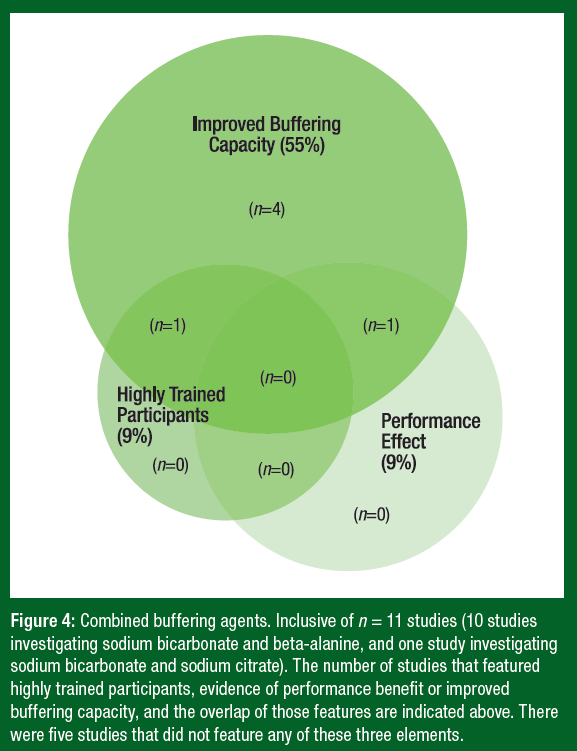
tests were relevant to real-world performance (8/11 studies) and the fact that only one of the included studies recruited highly trained participants. To enhance knowledge of this area, it is recommended that the combination of buffering agents be evaluated in the context of performance tests replicating real-world performance, such as trials in trained runners conducted on outdoor running tracks.
PRACTICAL APPLICATIONS
The importance of supplementation strategies that are specific to individual athletes has previously been emphasized in the literature (Maughan et al., 2018). This is particularly relevant given that, as discussed within this review and in published studies, there is a paucity of real-world considerations in the scientific literature, and the potential impact of factors such as sex differences, differences due to athletic calibre, use in extreme environments, and the combined use of extra-and intra-cellular buffering agents. Additionally, relevant considerations include the potential use of evidence-based supplements other than buffering agents (e.g., creatine or nitrate supplementation) (Burke, 2021), and athletes’ experience of gastrointestinal symptoms (after sodium bicarbonate and sodium citrate supplementation) and other side effects (e.g., paraesthesia after beta-alanine supplementation) (Breitkreutz et al., 2007; Liu et al., 2012; Saunders et al., 2014). We, therefore, provide a summary of the current evidence in this area, which we have applied to develop evidence-based supplementation strategies for individual athletes (Table 2).
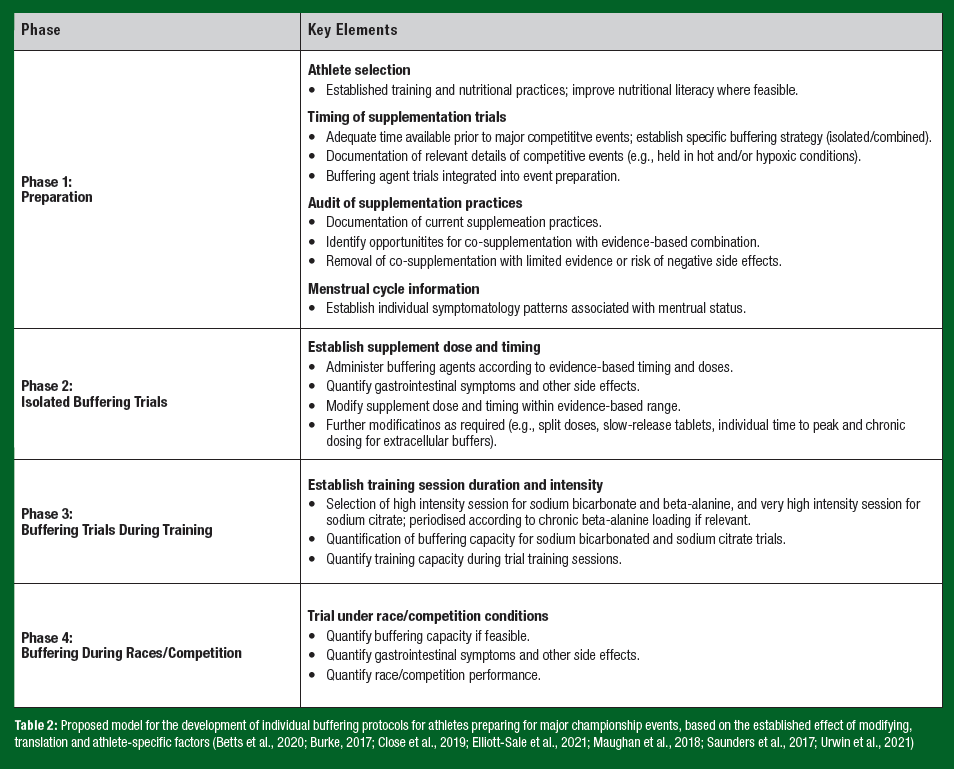
SUMMARY
This SSE article reviewed the scientific evidence that is relevant to athletes’ use of buffering agents, with specific consideration of three discrete scenarios: female athletes, extreme environments, and combined buffering agents. Across the included studies for all three scenarios, only 19% of the included studies for the three buffering agents reported a performance benefit, and only 10% recruited highly trained athletes. This low transferability of research findings to athletes’ real-world practices may be due to factors including the small number of sodium citrate studies in females (n = 2), no studies that control for menstrual status, and the limited number of beta-alanine studies using performance tests replicating real-world performance efforts (n = 3). It is recommended that further research into buffering agents in highly trained female athletes that controls or accounts for menstrual status, with studies that replicate the demands of heat and altitude camps, and investigations of highly trained athletes’ use of combined buffering agents to address these limitations. In a practical context, it is recommended that a staged approach is used to develop evidence-based buffering protocols using four phases (preparation, isolated buffering trials, buffering trials during training, buffering trials during competition) to develop an individually tailored protocol that reduces the likelihood of gastrointestinal symptoms and other side effects, and optimizes key moderating factors including dose, timing, duration, and intensity.
The views expressed are those of the authors and do not necessarily reflect the position or policy of PepsiCo, Inc.
REFERENCES
Betts, J.A., J. . Gonzalez, L.M. Burke, G.L. Close, I. Garthe, L.J. James, A.E. Jeukendrup, J.P. Morton, D.C. Nieman, and P. Peeling (2020). PRESENT 2020: Text expanding on the checklist for proper reporting of evidence in sport and exercise nutrition trials. Int. J. Sport Nutr. Exerc. Metab. 30:2-13.
Breitkreutz, J., T.G. Gan, B. Schneider, and P. Kalisch (2007). Enteric-coated solid dosage forms containing sodium bicarbonate as a drug substance: an exception from the rule? J. Pharm. Pharmacol. 59:59-65.
Burke, L.M. (2017). Practical issues in evidence-based use of performance supplements: supplement interactions, repeated use and individual responses. Sports Med. 47:79- 100.
Burke, L.M. (2021). Nutritional approaches to counter performance constraints in high‐level sports competition. Exp. Physiol. 106:2304-2323.
Cerullo, G., M. Parimbelli, S. Perna, M. Pecoraro, G. Liguori, M. Negro, and G. D’Antona (2020). Sodium citrate supplementation: An updated revision and practical recommendations on exercise performance, hydration status, and potential risks. Transl. Sports Med. 3:518-525.
Close, G.L., A.M. Kasper, and J.P. Morton (2019). From paper to podium: quantifying the translational potential of performance nutrition research. Sports Med. 49:25-37.
Dennig, H., J. Talbott, H. Edwards, and D. Dill (1931). Effect of acidosis and alkalosis upon capacity for work. J. Clin. Invest. 9:601-613.
Dill, D., H. Edwards, and J. Talbot. (1932). Alkalosis and the capacity for work. J Biol Chem 97(1):58-59.
Elliott-Sale, K.J., K.L. McNulty, P. Ansdell, S. Goodall, K.M. Hicks, K. Thomas, P.A. Swinton, and E. Dolan (2020). The effects of oral contraceptives on exercise performance in women: a systematic review and meta-analysis. Sports Med. 50:1785-1812.
Elliott-Sale, K.J., C.L. Minahan, X.A.J. de Jonge, K.E. Ackerman, S. Sipilä, N.W. Constantini, C.M. Lebrun, and A.C. Hackney (2021). Methodological considerations for studies in sport and exercise science with women as participants: a working guide for standards of practice for research on women. Sports Med. 51:843-861.
Erdman, K.A., T.S. Fung, P.K. Doyle-Baker, M.J. Verhoef, and R.A. Reimer (2007). Dietary supplementation of high-performance Canadian athletes by age and gender. Clin. J. Sport Med. 17:458-464.
Febbraio, M.A. (2001). Alterations in energy metabolism during exercise and heat stress. Sports Med. 31:47-59.
Gilsanz, L., J. López-Seoane, S. L. Jiménez, and H. Pareja-Galeano. (2023). Effect of β-alanine and sodium bicarbonate co-supplementation on the body’s buffering capacity and sports performance: A systematic review. Crit Rev Food Sci Nutr 63(21):5080-5093.Green, H.J., I. Fraser, and D. Ranney (1984). Male and female differences in enzyme activities of energy metabolism in vastus lateralis muscle. J. Neurol. Sci. 65:323-331.
Guy, J., G. Deakin, A. Edwards, C. Miller, and D. Pyne (2015). Adaptation to hot environmental conditions: an exploration of the performance basis, procedures and future directions to optimise opportunities for elite athletes. Sports Med. 45:303-311.
Harris, R.C., M. Tallon, M. Dunnett, L. Boobis, J. Coakley, H.J. Kim, J.L. Fallowfield, C. Hill, C. Sale, and J.A. Wise (2006). The absorption of orally supplied β-alanine and its effect on muscle carnosine synthesis in human vastus lateralis. Amino Acids 30:279-289.
Hegge, A.M., E. Bucher, G. Ettema, O. Faude, H.-C. Holmberg, and Ø. Sandbakk (2016). Gender differences in power production, energetic capacity and efficiency of elite cross-country skiers during whole-body, upper-body, and arm poling. Eur. J. Appl. Physiol. 116:291-300.
Janssen, I., S.B. Heymsfield, Z. Wang, and R. Ross (2000). Skeletal muscle mass and distribution in 468 men and women aged 18–88 yr. J. Appl. Physiol. 89:81-88.
Liu, Q., P. Sikand, C. Ma, Z. Tang, L. Han, Z. Li, S. Sun, R.H. LaMotte, and X. Dong (2012). Mechanisms of itch evoked by beta-alanine. J. Neurosci. 32:14532-14537.
Maughan, R., L. Burke, J. Dvorak, D. Larson-Meyer, H. Geyer, R. Meeusen, L. van Loon, S. Shirreffs, L. Spriet, M. Stuart, A. Vernec, K. Currell, V. Ali, R. Budgett, A. Ljungqvist, M. Mountjoy, Y. Pitsiladis, T. Soligard, U. Erdener, and L. Engebretsen (2018). IOC consensus statement: dietary supplements and the high-performance athlete. Br. J. Sports Med. 52:439-455.
McDermott, B.P., S.A. Anderson, L.E. Armstrong, D.J. Casa, S.N. Cheuvront, L. Cooper, W.L. Kenney, F.G. O'Connor, and W.O. Roberts (2017). National Athletic Trainers' Aassociation Position Statement: Fluid Replacement for the Physically Active. J. Athl. Train. 52::877-895.
McKay, A.K., T. Stellingwerff, E.S. Smith, D.T. Martin, I. Mujika, V.L. Goosey-Tolfrey, J. Sheppard, and L.M. Burke (2022). Defining training and performance caliber: a participant classification framework. Int. J. Sports Physiol. Perform. 17:317-331.
McNulty, K.L., K.J. Elliott-Sale, E. Dolan, P.A. Swinton, P. Ansdell, S. Goodall, K. Thomas, and K. M. Hicks (2020). The effects of menstrual cycle phase on exercise performance in eumenorrheic women: a systematic review and meta-analysis. Sports Med. 50:1813- 1827.
Millet, G., B. Roels, L. Schmitt, X. Woorons, and J. Richalet (2010). Combining hypoxic methods for peak performance. Sports Med. 40:1-25.
Mujika, I., A. Sharma, and T. Stellingwerff (2019). Contemporary periodization of altitude training for elite endurance athletes: a narrative review. Sports Med. 49:1651–1669.
Nelson, M.D., L.A. Stuart-Hill, and G.G. Sleivert (2008). Hypervolemia and blood alkalinity: effect on physiological strain in a warm environment. Int. J. Sports Physiol. Perform. 3:501-515.
Oliveira, L.F., E. Dolan, P.A. Swinton, K. Durkalec-Michalski, G.G. Artioli, L.R. McNaughton, and B. Saunders (2022). Extracellular buffering supplements to improve exercise capacity and performance: A comprehensive systematic review and meta-analysis. Sports Med. 52:505-526.
Porter, M., S. Stuart, M. Boij, and J. Lexell (2002). Capillary supply of the tibialis anterior muscle in young, healthy, and moderately active men and women. J. Appl. Physiol. 92:1451-1457.
Russ, D.W., I.R. Lanza, D. Rothman, and J.A. Kent‐Braun (2005). Sex differences in glycolysis during brief, intense isometric contractions. Muscle Nerve 32:647-655.
Saunders, B., C. Sale, R.C. Harris, and C. Sunderland (2014). Sodium bicarbonate and high-intensity-cycling capacity: variability in responses. Int. J. Sports Physiol. Perform. 9:627-632.
Saunders, B., K. Elliott-Sale, G. . Artioli, P. . Swinton, E. Dolan, H. Roschel, C. Sale, and B. Gualano (2017). β-alanine supplementation to improve exercise capacity and performance: a systematic review and meta-analysis. Br. J. Sports Med. 51:658-669.
Saunders, B., L.F. Oliveira, E. Dolan, K. Durkalec-Michalski, L. McNaughton, G.G. Artioli, and P.A. Swinton (2022). Sodium bicarbonate supplementation and the female athlete: A brief commentary with small scale systematic review and meta-analysis. Eur. J. Sport Sci. 22:745-754.
Shaw, G., G. Slater, and L.M. Burke (2016). Supplement use of elite Australian swimmers. Int. J. Sport Nutr. Exerc. Metab. 26:249-258.
Smith, E.S., A.K. McKay, M. Kuikman, K.E. Ackerman, R. Harris, K.J. Elliott-Sale, T. Stellingwerff, and L.M. Burke. (2022). Auditing the representation of female versus male athletes in sports science and sports medicine research: Evidence-based performance supplements. Nutrients 14:953.
Sobal, J., and L.F. Marquart. (1994). Vitamin/mineral supplement use among athletes: a review of the literature. Int. J. Sport Nutr. Exerc. Metab. 4:320-334.
Stellingwerff, T., P. Peeling, L.A. Garvican-Lewis, R. Hall, A.E. Koivisto, I.A. Heikura, and L.M. Burke (2019). Nutrition and altitude: strategies to enhance adaptation, improve performance and maintain health: a narrative review. Sports Med. 49:169-184.
Sundgot–Borgen, J., B. Berglund, and M.K. Torstveit (2003). Nutritional supplements in Norwegian elite athletes—impact of international ranking and advisors. Scand. J. Med. Sci. Sports 13:138-144.
Suvi, S., M. Mooses, S. Timpmann, L. Medijainen, D. Narõškina, E. Unt, and V. Ööpik (2018). Impact of sodium citrate ingestion during recovery after dehydrating exercise on rehydration and subsequent 40-km cycling time-trial performance in the heat. Appl. Physiol. Nutr. Metab. 43:571-579.
Urwin, C.S., R.J. Snow, D. Condo, R. Snipe, G.D. Wadley, and A.J. Carr (2021). Factors influencing blood alkalosis and other physiological responses, gastrointestinal symptoms, and exercise performance following sodium citrate supplementation: A review. Int. J. Sport Nutr. Exerc. Metab. 31:168-186.
Vaher, I., S. Timpmann, M. Aedma, and V. Ööpik (2015). Impact of acute sodium citrate ingestion on endurance running performance in a warm environment. Eur. J. Appl. Physiol. 115:813-823.